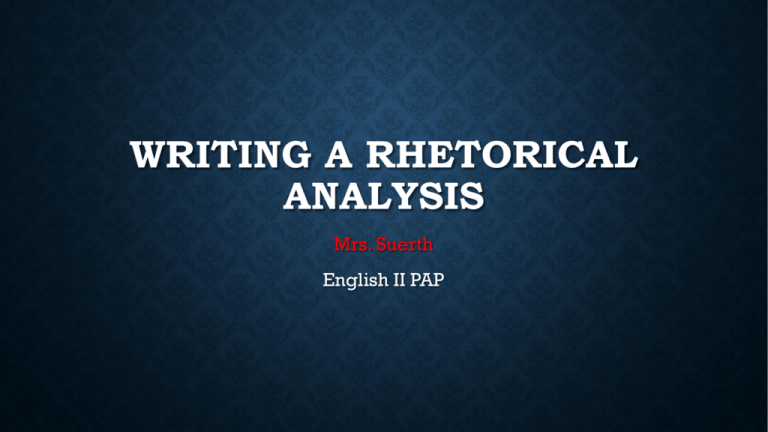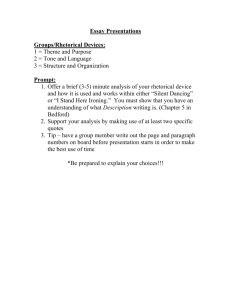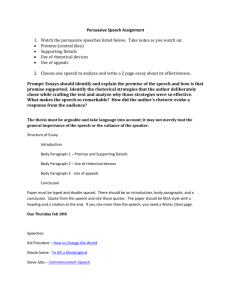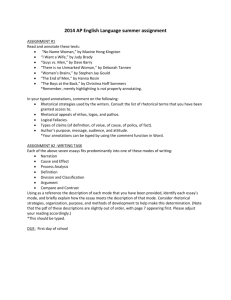PPT - SOAPSTone & Rhetorical Analysis
advertisement

WRITING A RHETORICAL ANALYSIS Mrs. Suerth English II PAP WHAT EXACTLY IS RHETORICAL ANALYSIS? • What is the difference between a rhetorical analysis and a persuasive essay? • In a persuasive essay, you write your OWN thoughts from your own point of view in order to persuade your audience (and hopefully you are using rhetorical techniques). • In a rhetorical analysis, you are analyzing someone else’s persuasive techniques by examining the rhetorical devices THEY have used to convey their point of view. WHY SHOULD I CARE? • If you plan to take AP English III, ie. AP Language, next year, you will have to write THREE of these in a span of 120 minutes. WHY SHOULD I CARE? • The analysis of rhetoric used by others, whether it is in a speech, writing, or other means of communication, helps you recognize when you are being persuaded, manipulated, and makes you a more savvy consumer of information. (Think about how the commoners in Julius Caesar were so easily manipulated by the rhetorical techniques used in Antony’s funeral speech…you don’t want to be like them!) HOW DO I WRITE A RHETORICAL ANALYSIS? You have learned about rhetorical techniques this year, and we have reviewed different strategies used by writers to convey their point of view. In a rhetorical analysis, you just have to put all that together to analyze someone else’s work. Here is an easy acronym that will help you get started: SOAPSTone! My, what a pretty countertop! NO, NO, NO, NOT THAT SOAPSTONE! SOAPSTone refers to: Speaker, Occasion, Audience, Purpose, Subject, and Tone WHAT IS SOAPSTONE? • Speaker: The voice that tells the story • Occasion: The time and the place of the piece; the context that prompted the writing. • Audience: The group of readers to whom this piece is directed • Purpose: The reason behind the text • Subject: The topic of the piece of writing • Tone: The attitude of the author SPEAKER • While reading the text, ask yourself this major question: WHO IS SPEAKING? • Don’t confuse the author with the speaker. They are two different voices; sometimes two different personas. For example, Shakespeare is the author of the play Julius Caesar, but the speaker is Antony trying to influence the commoners to revolt against Brutus and the rest of the conspirators. • Ask yourself: What’s the point of a speaker? Why do we care who is speaking? How does it influence the text? How does it influence the reader? • Who is speaking to the reader? Is it an economist? A fashion guru? A teacher? A lawmaker? OCCASION • While reading, it’s important to determine WHAT EVENT INFLUENCED THE TEXT. (Obviously, in Julius Caesar, it’s Caesar’s murder when referencing Antony’s speech) • Why do we write? Why does it matter? Do we just write about anything and everything, or are we influenced to write? • Ask yourself: Why is this person writing this text now? What major event or occurrence inspired this piece of writing? • Are they writing in response to a new law? An ongoing war? A celebrity mishap? A major world crisis? AUDIENCE • While reading the text, it is important to determine WHO THE AUDIENCE IS. • Don’t think an article on the health risks of elementary school cafeteria food is an article for just anyone. Who could an article like that be targeting? • Ask yourself: Who is the intended audience for this text? Why write to this specific audience? Why cant a piece of writing be meant for EVERYBODY? • Is the audience the financial experts of the business world? Stay-at-home mothers? College students? Athletes? PURPOSE • While reading the text, it is necessary to understand the PURPOSE OF THE TEXT. • Ask yourself: What’s the purpose of the writing? What is it intended to do? What is the speaker hoping to achieve? Is there a goal? • Are they trying to influence consumers to buy a certain product? Vote for a specific politician? Save their money by investing? Send their kids to private school? SUBJECT • While reading the text, determine the SUBJECT OF THE TEXT. • Ask yourself: What is this piece of writing about? What topic(s) does it concern? Why does it matter? • Are they writing about the war in Iraq? A new law that just passed? A hot, new celebrity? TONE • While reading the text, one of the most important questions is WHAT’S THE TONE OF THE TEXT? • How is the author saying what he’s saying? What is his attitude towards the subject? Towards the audience? • Is he angry? Biased? Persuasive? Neutral? THE ANALYSIS PARAGRAPH • An analysis paragraph must prove something by using the text as evidence. • Follow the specific paragraph outline if you want to write an outstanding paragraph. • DO’s and DON’TS: • DO state your point in the topic sentence • DON’T forget to provide the WHY and HOW SO? • DO cite your evidence • DON’T use a quote without explaining its significance • DO follow the paragraph outline AN OUTLINE OF AN ANALYSIS BODY PARAGRAPH • Topic Sentence (TS): One sentence that states your point; it states what you’re trying to prove. • Setup (S): Sets up the context for your first piece of evidence from the source (quote). • Evidence(E #1): Your first piece of evidence; a quote from the source. • Commentary (CM): Three to five sentences that explains the significance of the quote. How does it help prove your point? THIS SHOULD NOT INCLUDE A SUMMARY OF YOUR QUOTE. You are assuming your audience can read..duh! • Conclusive Sentence (CS): One sentence that wraps up your paragraph. RHETORICAL ANALYSIS ESSAY STRUCTURE Your essay should include an INTRODUCTION, with a brief summary of the material/source that you are analyzing, followed by your THESIS sentence outlining your main points you will make in your analysis. BODY PARAGRAPHS • Your essay should include THREE body paragraphs. • For each body paragraph, you will need to include the following: • Topic sentence, setup for your evidence, evidence (quote from source), analysis/commentary, and a concluding sentence. • Remember to address SOAPSTone in your body paragraphs. CONCLUSION • A conclusion, which restates the thesis sentence and leaves the reader with a final thought about your essay. • Sounds familiar, doesn’t it? Don’t be afraid of the words “rhetorical analysis.” Your writing follows the SAME FORMAT that you know and love; your AUTHOR’S PURPOSE is simply to analyze for rhetorical techniques. YOU’VE GOT THIS, Y’ALL!






